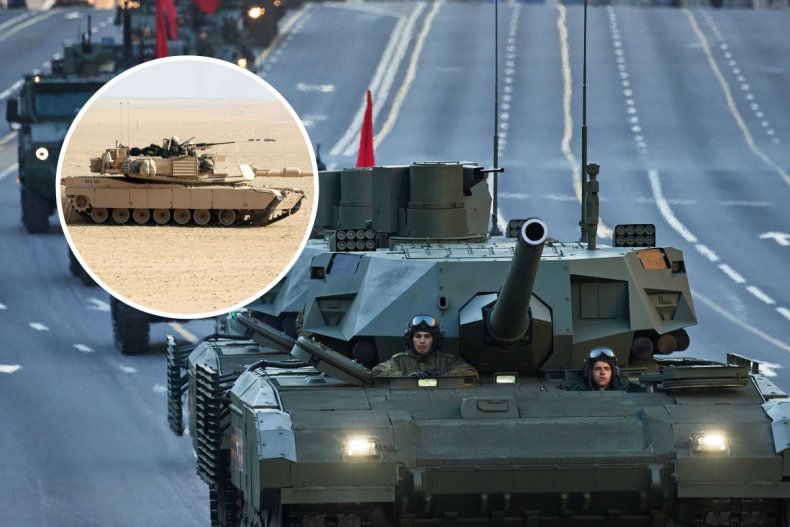ELLIE COOK

The U.S.-made Abrams tank, widely considered to be the gold standard of main battle tanks, will roll towards the Ukrainian front lines, President Joe Biden announced last week. However, the Russian T-14 Armata, dubbed a "super tank," could also be heading for battle, according to recent defense assessments.
The Abrams tanks "are the most capable tanks in the world," Biden said last Wednesday as he committed 31 Abrams to Kyiv. The tank "sends a message to those who would oppose the United States," the U.S. Army Acquisition Center wrote in a summary of the main battle tank.
Meanwhile, Kremlin spokesperson Dmitry Peskov responded to the announcement, which came just after Germany promised Leopard 2 tanks to Ukraine, by commenting that the Abrams "would burn up just like all the others" on the front lines. Pentagon spokesperson Sabrina Singh said the reaction from Moscow was not new, and Washington, D.C., had "heard that line before."
A Russian T-14 Armata tank participates in a Victory Day Parade night rehearsal on Tverskaya street on May 4, 2022 in Moscow, Russia, with an inset of an M1A1 Abrams Tank with U.S. Task Force 1-64 from the 3rd Infantry Division, Fort Stewart, Georgia, during a combined live fire exercise in 2002. The U.S. will send 31 Abrams tanks to Ukraine, and the British defense ministry has suggested Russia could deploy its T-14 Armata tanks.
In a clip uploaded and subtitled by Gerashchenko, a Russian state presenter can be heard detailing the best methods to destroy a U.S. Abrams tank, then contrasted with a list of advantages it claimed the Russian T-14 Armata possessed.
"They are high-tech vehicles with complex sensors, data transmitters and on-board drones," the translation reads.
The T-14 Armatas did cause quite the stir when they were debuted in Moscow back in 2015. One British army intelligence official said the following year that the T-14 was deserving of "its billing as the most revolutionary tank in a generation."
"Without hyperbole, Armata represents the most revolutionary step change in tank design in the last half century," the unnamed official wrote in a briefing paper obtained by The Telegraph.
The T-14 Armata is truly set apart from other main battle tanks by its unmanned turret, able to support a 125mm cannon, the assessment said. The crew, rather than being located within the turret, are placed in an armored "capsule" within the tank's hull.
"For the first time, a fully automated, digitised, unmanned turret has been incorporated into a main battle tank. And for the first time a tank crew is embedded within an armoured capsule in the hull front," the briefing paper said.
This increases survivability for the three crew members on board.
Retired British Army Brigadier Ben Barry told the outlet at the time that this turret design could potentially accommodate a 150mm caliber gun, which would "overmatch the guns and armour on existing Nato tanks."
The M1 Abrams tanks, which come in several variants, are fitted with 105mm or 120mm armaments. The M1, depending on the model, weighs in at between 67.6 and 73.6 tons, with a maximum speed of 42 miles per hour and 30 mph cross country.
The T-14 Armatas can have a top speed of around 55mph, a maximum weight of 53 tons, and have an adaptable chassis.
However, both tanks have their drawbacks. Biden said the M1 Abrams are "extremely complex to operate and maintain."
NATO official says alliance "ready" for direct confrontation with Russia
In their development, the T-14 Armatas were quickly hit by a slew of hitches. The 11-year program was "dogged with delays, reduction in planned fleet size, and reports of manufacturing problems," the British defense ministry said in a tweet earlier this month.
A bigger, bulkier tank than many of Russia's existing tanks, the T-14 poses logistical issues whose deployment would be a "high-risk decision for Russia," the ministry added on January 19.
There had been issued with the T-14's engine and thermal imaging systems, the government department said, evaluating that any deployment of the T-14 in Ukraine would "likely primarily be for propaganda purposes."
Production "is probably only in the low tens," and Russian commanders "are unlikely to trust the vehicle in combat," the ministry said. The U.S. has thousands of Abrams tanks in storage.
In further bad news for the T-14s, the British defense ministry said in an updated assessment last Wednesday that Russian commanders in Ukraine "were reluctant to accept the first tranche of T-14 allocated to them because the vehicles were in such poor condition."
It has not yet been confirmed whether Russia has deployed the T-14 in Ukraine, but Moscow is "very unlikely" to send them in any numbers because they cannot afford to lose any, Newsweek was told on Thursday.
Frank Ledwidge, a barrister and former military officer who served in the Middle East and the Balkans, said that any publicity around the T-14 Armata being destroyed in Ukraine would jeopardize important export sales.
"They are more likely to drive around behind the lines," rather than be deployed to the heart of the conflict, he added.
No comments:
Post a Comment